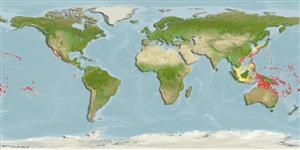Environment: milieu / climate zone / depth range / distribution range
Ecologia
marino associati a barriera corallina; distribuzione batimetrica 0 - 64 m (Ref. 27370), usually 0 - 40 m (Ref. 37816). Tropical
Pacific Ocean: southern Japan to New Caledonia, Hawaii and Pitcairn.
Size / Peso / Age
Maturity: Lm ? range ? - ? cm
Max length : 23.0 cm SL maschio/sesso non determinato; (Ref. 27370); common length : 15.0 cm TL maschio/sesso non determinato; (Ref. 9137)
Spine dorsali (totale) : 11; Raggi dorsali molli (totale) : 14; Spine anali: 4; Raggi anali molli: 9 - 11. Body with alternate red and yellow stripes dorsally, and with red and silvery white on side; ventrally, the yellow stripes often as a series of close-set spots, one per scale; head red, an oblique silvery white streak below eye and a vertical one on edge of preopercle; spinous dorsal fin yellow with narrow red margin; white caudal fin with a submarginal red band in each lobe, converging and broadening basally. Five oblique rows of scales on cheek. Body depth 2.5-2.85 in SL; head length 2.6-2.95 in SL; snout length 3.4-3.9 in head length; interorbital width 5.3-6.0 in head length; slightly projecting lower jaw. Maxilla either extending slightly beyond a vertical at front edge of pupil or reaching below center of eye; upper jaw length 2.3-2.65 in head length; premaxillary groove extending to or slightly posterior to a vertical at anterior edge of orbit; anterior end of nasal bone rounded; medial margin of nasal bone without spinule; edge of nasal fossa with 1 to 7 spinules; upper edge of suborbital bones below anterior half of eye without a spine or serrae (below posterior half weakly serrated); preopercular spine about 2/3 times in orbit diameter, 4.3-5.3 in head length; 1st and 2nd dorsal spine subequal, usually the 3rd is the longest, 2.15-2.7 in head length; 3rd anal spine 1.55-1.75 in head length. Usually 10 anal soft rays (Ref. 27370).
Inhabits deep reefs (Ref. 27370). Benthopelagic in or near crevices and caves (Ref. 58302). Feeds on small fishes and crustaceans (Ref. 89972).
Life cycle and mating behavior
Maturità | Riproduzione | Deposizione | Uova | Fecundity | Larve
Randall, J.E., 1998. Revision of the Indo-Pacific squirrelfishes (Beryciformes: Holocentridae: Holocentrinae) of the genus Sargocentron, with descriptions of four new species. Indo-Pac. Fish. (27):105 p. (Ref. 27370)
IUCN Red List Status (Ref. 130435: Version 2024-2)
Threat to humans
Harmless
Human uses
Pesca: commerciale
Strumenti
Special reports
Download XML
Fonti Internet
Estimates based on models
Preferred temperature (Ref.
123201): 24.4 - 29, mean 27.4 °C (based on 618 cells).
Phylogenetic diversity index (Ref.
82804): PD
50 = 0.5000 [Uniqueness, from 0.5 = low to 2.0 = high].
Bayesian length-weight: a=0.01660 (0.00788 - 0.03495), b=2.97 (2.80 - 3.14), in cm total length, based on LWR estimates for this Genus-body shape (Ref.
93245).
Trophic level (Ref.
69278): 4.0 ±0.67 se; based on food items.
Resilienza (Ref.
120179): Alto, tempo minimo di raddoppiamento della popolazione meno di 15 mesi (Preliminary K or Fecundity.).
Fishing Vulnerability (Ref.
59153): Low vulnerability (18 of 100).
Nutrients (Ref.
124155): Calcium = 53.8 [20.8, 214.3] mg/100g; Iron = 0.49 [0.19, 1.48] mg/100g; Protein = 18.7 [17.5, 19.9] %; Omega3 = 0.163 [0.071, 0.372] g/100g; Selenium = 32.2 [18.8, 62.8] μg/100g; VitaminA = 89.4 [34.6, 246.8] μg/100g; Zinc = 1.67 [0.69, 3.14] mg/100g (wet weight);
